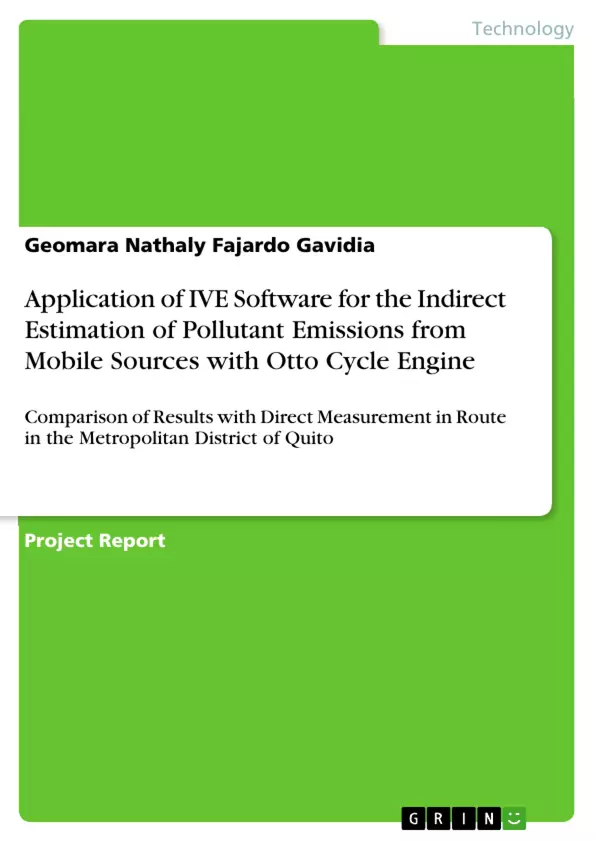This article deals with the application of the IVE software for the indirect estimation of pollutant emissions from mobile sources with Otto cycle engine and comparison of results with direct measurement in route in the Metropolitan District of Quito.
For the indirect estimation, we proceeded to quantify time data, altitude and speed with a GPS, these values were adjusted with a data filtering program to generate the matrix file for the development of the IVE program to later enter vehicle technology data, atmospheric conditions, time and date of the test and thus obtain global polluting emissions.
For the direct measurement three routes were developed: city cycle, road cycle, combined cycle in which On-Board measuring equipment was used, to collect pollutant emissions values in route, and an external tank to quantify the fuel consumption in each trip.
Inhaltsverzeichnis (Table of Contents)
- 1. INTRODUCTION
- 1.1. Air pollution problem
- 1.2. IVE software application
- 2. METHODOLOGY
- 2.1. Selection of test vehicle
- 2.2. Selection of the on-road test cycle
- 2.3. Equipment
- 2.3.1. Gas analyzer On Board
- 2.3.2. (GPS)
- 2.4. Determination of the emission factor using IVE software
- 2.5. Emission factor determination with on-board measurement
- 3. RESULTS AND ANALYSIS
- 3.1. Emission Factors
Zielsetzung und Themenschwerpunkte (Objectives and Key Themes)
The main objective of this article is to assess the application of the IVE software for indirectly estimating pollutant emissions from mobile sources with Otto cycle engines. The study aims to compare these estimations with direct measurements obtained from on-road testing in the Metropolitan District of Quito. This research explores the accuracy of the IVE software in a real-world context, specifically focusing on the city's unique environmental conditions.
- Comparison of indirect and direct emission measurements
- Accuracy of the IVE software in real-world conditions
- Development of a correction factor to adapt IVE to Quito's environment
- Impact of vehicular emissions on air quality in Quito
- Evaluation of emission factors for different vehicle types and driving cycles
Zusammenfassung der Kapitel (Chapter Summaries)
- Introduction: This chapter introduces the issue of air pollution in Quito, emphasizing its connection to vehicular emissions. It highlights the importance of accurate emission data for developing effective environmental policies. The chapter also provides a brief overview of the IVE software and its application in Latin American cities.
- Methodology: This chapter outlines the two protocols used in the study, one for indirect estimation with IVE software and the other for direct on-road measurement. The selection of test vehicles, routes, and equipment are detailed, including specifications of the chosen vehicles and measuring instruments.
- Results and Analysis: This chapter presents the emission factors calculated using both the IVE software and on-road measurements. The results are tabulated and analyzed, highlighting significant differences between the two methods. The chapter further discusses the need for a correction factor to improve the IVE software's accuracy in Quito's specific conditions.
Schlüsselwörter (Keywords)
The article focuses on the key topics of air pollution, vehicular emissions, Otto cycle engines, IVE software, emission factors, direct measurement, on-road testing, Quito, environmental conditions, and correction factors. The research investigates the effectiveness of the IVE software in real-world settings and analyzes the variation between indirect and direct emission data for different vehicle types and driving cycles.
- Arbeit zitieren
- Geomara Nathaly Fajardo Gavidia (Autor:in), 2018, Application of IVE Software for the Indirect Estimation of Pollutant Emissions from Mobile Sources with Otto Cycle Engine, München, GRIN Verlag, https://www.hausarbeiten.de/document/1299290


